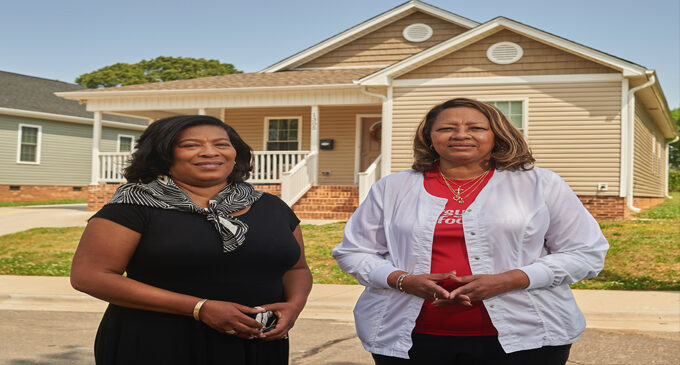Atkins CDC is model for scaling up workforce housing
Carol Davis, executive director of the Atkins CDC (on the left) and Virginia Hardesty, president of the Atkins CDC board, in front of one of the new houses the CDC has built on Hardesty Lane.

By John Railey
On a recent afternoon, Carol Davis and Virginia Hardesty walked down Hardesty Lane, just off Martin Luther King Jr. Drive in Winston-Salem. The street had once sagged, but is now graced by several new houses of first-time homebuyers, thanks to the efforts of Davis and Hardesty. “Many of the homes in East Winston neighborhoods are not owned by the people who live here,” Davis said. “It’s not good when money flows out of the neighborhood. It creates a stronger neighborhood economy when the houses are owned by people who live here.”
Meeting the city and Forsyth County’s demand for thousands of units of affordable, or workforce, housing in the next decade is going to take an organized effort among public and private partnerships. The new houses on Hardesty Lane, engineered under the leadership of Davis and Hardesty through their S.G. Atkins Community Development Corp., which was started by Winston-Salem State University and is an affiliated entity of it, is one good model.
As housing prices surged 16% this year, according to Redfin.com, workforce housing for police, firefighters, restaurant, hospital and biotech workers, to name a few groups, has gotten harder to find. One key avenue has been the Forsyth County Homeownership Program, which has helped hundreds of local residents buy homes over the last 20 years. But with only a few dozen homeowners helped per year and 70 qualified buyers from their program on a waiting list for houses, it’s a drop in the bucket relative to the shortage of housing.
WSSU’s Center for the Study of Economic Mobility (CSEM) has extensively studied the county program. Scaling it up, as well as other local ones, would play a key role in meeting the workforce housing challenge. By way of full disclosure, CSEM is applying for grants to support its research on that effort.
The Atkins CDC has received most of its support in building houses from the city’s Housing and Community Services Division. Davis is the executive director of the CDC. Hardesty, the owner of the bedrock Forsyth Seafood by Hardesty Lane, is the president of the CDC board. The lane is named for her and her late husband, Charlie. It is a big chunk of the CDC’s innovative movement for workforce housing. Since 2001, the CDC has put 32 families in homes, primarily in East Winston. Davis is also the special assistant for Community Development and Engagement to WSSU Chancellor Elwood Robinson.
Public money is available to ramp up the housing effort. Councilman Jeff MacIntosh has said Mayor Allen Joines has proposed $20 million from American Relief Plan Act (ARPA) funding to go for affordable housing, and MacIntosh believes the council will sign off on that proposal. The state of North Carolina has allocated an additional $10 million to the city for affordable housing, he said, and more than $1 million may be available for affordable housing from bonds approved in 2018. Forsyth County has about $20 million left in ARPA funding, and some of that could potentially go to further support the homeownership program, staff and commissioners indicated at a March meeting.
Davis said: “If they will fund us, we can build some more houses.”
The challenge for meeting the housing demand, local automobile dealer Don Flow has said, is leveraging institutions already in place and involving builders, bankers and many others. “If we want to be an affordable and desirable city for the future, we need to immediately put in place a plan to build 500 homes, and we don’t need to slow down until we cross 5,000 homes. If we do this, we will be known as a city that provides the opportunity for all of our citizens to thrive.”
Davis said: “The strong ecosystem for first-time homebuyers includes Experiment in Self-Reliance, Financial Pathways of the Piedmont, the Center for Homeownership, the city and the county. The best way to do this is partnerships. Take that public money and put it to work.”
The Atkins CDC works with builder Bill Crews, a WSSU graduate who worked in banking and is now a builder, sharing the CDC’s dream for workforce housing. “He is a quality contractor,” Hardesty said.
Through the Clean Energy Initiative of the HBCU Community Development Action Coalition, Davis was able to get solar panels on four new homes on Hardesty Lane at no cost to the homeowners. A grant provided $15,000 per home to purchase the panels that the four homeowners are excited to get and they each are expected to save $700 per year on the Duke Energy bill. “I hope that this $700 savings will go into their retirement savings or be invested in a 529 plan for their children to go to college,” Davis said. “Maybe they’ll go to WSSU.”
Hardesty is on the board of Piedmont Federal Savings Bank, which is instrumental in helping first-time homebuyers. More public awareness is needed to let those buyers know about the help that’s out there, she said.
The challenges in building workforce housing are significant. The Atkins CDC might buy an old house in East Winston for $15,000, then spend $7,000 to tear it down. So by the time they are ready to contract to build a house, they are already $22,000 in the hole. The pandemic, with workers out and building supply shortages, makes it all the harder. And out-of-town investors, coming in with cash to turn existing houses into rental ones, are a constant threat.
Davis said that “just a few years ago, we were able to sell houses on Hardesty Lane for from $105,000 to $115,000. Now it’s $165,000 for 1,230 square feet in this crazy market. But the owners of those first houses, most of whom are still there, have seen that appreciation.
“We’re keeping our prices down as much as we can as we go forward and providing a quality product to the market for first-time homebuyers. Most of our clients have been mothers, social workers, teachers, health- care workers and administrative assistants.”
Hardesty Lane is working. Only one house on the street has been bought by an investor and turned into a rental house.
Davis said: “Equity in a house doesn’t hurt, for passing on wealth and starting a business. Whatever these homeowners want to do. There’s so much need and there are so many buyers right now that we just want to do as much as we can as fast as we can.”
John Railey, raileyjb@gmail.com, is the writer-in-residence for CSEM, www.wssu.edu/csem.











